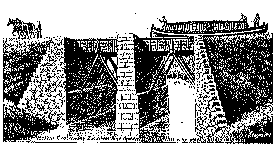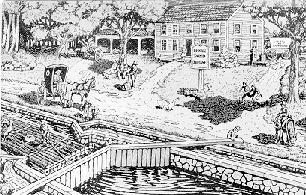
When the Road was a River
by Michael Kenney, The Boston Globe, printed July 3, 1999
It was "the Big Dig of its day," says Thomas Raphael, chairman of the state's Middlesex Canal Commission.
Take that literally, because the canal was not just a transit route set in a ditch, but a technological marvel whose half-million-dollar cost in 1803 prompted the secretary of the Treasury to call it "the greatest work of its kind that has been completed in the United States." Sound familiar?
The Middlesex Canal, a water highway of its day, ran 27 miles from Lowell to Charlestown. The route, along with the Blackstone Canal that ran 45 miles between Worcester and Providence, highlighted a half-century period when canals were a prime way to haul freight through New England and to carry the region into the Industrial Revolution - before the coming of the railroads. Such canals were smooth alternatives to rocky, rutted, and muddy roads.
Today, much of the Middlesex Canal is buried under roads and parking lots - even its southern end at Sullivan Square, formerly at the head of Prison Point Bay, is now close to a mile inland.
Many traces of the old waterway remain only as dirt-filled paths through suburban backyards, and at the MDC's Sandy Beach Reservation in Winchester. Boston's Canal Street is where the route once extended from the Charles River to Boston Harbor.
But it's still possible to find an unguided and unmarked way along a dozen stretches of the canal where its waters still flow through granite embankments.

A key landmark is in Woburn, at Baldwin's, the restaurant near the junction of Routes 128 and 38 that is in the elegantly restored mansion erected by Loammi Baldwin, the canal's builder.
On a recent afternoon, Nancy O'Connell, who owns the restaurant with her husband, steered a visitor toward the canal's towpath, where horses pulled the barges loaded with goods. Now, the towpath more closely resembles a mountain bike trail, but it runs for a half-mile. At several points, it's possible to push through the brush down to the canal itself and to look across at a second mansion, where Baldwin held a gala ball to celebrate the canal's opening.
Also unmarked, but more accessible, is the Millpond on the Concord River in Billerica. There, against a backdrop of l9th-century mills and a dam, Raphael and other canal buffs dream of putting in hiking trails and bikeways, even a visitors center and a heritage park - and of the bustle that reigned when barges ruled.
Exponential growth
Despite the difficulty and cost of building them, the canals proved far more efficient than wagons. Unfortunately, railroads eventually proved far more efficient than canals.
As Raphael said, "With a wagon and a team of oxen, you could carry maybe 3 tons. On a canal barge pulled by just one horse, you could carry 30 tons. But on a railroad, maybe you'd carry 300 tons. That's the exponential way things were going."
A company to build the Middlesex Canal was organized in 1793 by James Sullivan, later governor of Massachusetts and for whom Sullivan Square at the canal's Charlestown end was named. Colonel Baldwin, who became the project's superintendent, was Sullivan's partner. The digging began in 1795, with local farmers working when not tending their fields, and it was completed eight years later.
Unlike today's Big Dig, the canal was built with private funds - but it had the same cost overruns, as Mary Stetson Clarke notes in her history "The Old Middlesex Canal."
There was the ditch itself, 30 feet wide and 3 feet deep between a tow path and a protective berm. In addition, there was a series of 20 locks to successively raise the canal to its highest point, in Billerica. And there were eight aqueducts to carry the canal over small streams - rather then lower it to their level.
 From the Boston end, through locks and along aqueducts, barges would be lifted 107 feet above tidewater at Charlestown (or, from the other direction, 25 feet above the Merrimack River). A floating towpath - buoyant on a crisscross of logs - allowed horses to haul barges across the millpond. Still visible in Boston on the mill side of Faulkner Street are parts of the locks through which the barges passed.
From the Boston end, through locks and along aqueducts, barges would be lifted 107 feet above tidewater at Charlestown (or, from the other direction, 25 feet above the Merrimack River). A floating towpath - buoyant on a crisscross of logs - allowed horses to haul barges across the millpond. Still visible in Boston on the mill side of Faulkner Street are parts of the locks through which the barges passed.
"Additional funds were continually needed as unexpected expenses arose," Clarke wrote of the construction. "The rebuilding of embankments that sank and continued to sink was extremely costly. Material for watertight mortar had to be imported at considerable outlay. Stonework on the locks ran into high sums. Unsuspected ledge required tedious and expensive excavation. At every turn the superintendent ran into situations that had only one thing in common - the inescapable fact that more money was necessary to effect a solution."
South along the canal upon its completion moved raw materials lumber, granite, and agricultural products. On the return trip north, there were manufactured products.
Transported into Woburn from New Hampshire forests came the tree bark used in the leather-tanning process. "It changed life in Woburn," said Thomas Smith, one of that city's members on the Middlesex Canal Commission. "Having access to the bark made it possible for the leather industry to grow" in what had been a rural agricultural community.
And the extension into Boston, said Raphael, made Haymarket Square "the city's gas station" - explaining that hay from farms along the canal's route was the "fuel" for the horses that drew the city's carriages and wagons.
 Even then, the canal provided sightseeing excursions, with one of the region's first amusement parks built along it at Horn Pond in Woburn, complete with bowling alleys, taverns, and dance pavilions.
Even then, the canal provided sightseeing excursions, with one of the region's first amusement parks built along it at Horn Pond in Woburn, complete with bowling alleys, taverns, and dance pavilions.
But within just 50 years, it all came to an end because of a nearby replacement.
A plan for the Boston and Lowell Railroad, drawn in 1836, shows the proposed route for a railroad running parallel to the canal. The surveyor was none other than the son of Colonel Baldwin. In mapping the railroad, he worked off the original survey done for the canal.
Thirty-ton loads were no match for 300-ton ones, and the canal faded into the brush and under the developers' shovels. (Even rail lines change. The Lowell route is now an MBTA commuter line.)
A dream revived
Interest in the canal revived in the late 1960s when local history buffs formed a Middlesex Canal Association - which was followed by the creation of the Middlesex Canal Commission, the state agency that Raphael heads.
There was even a period in the mid-1970s when the stretch of canal past the Baldwin mansion in Woburn was cleared of brush and debris and a replica of a canal barge gave trips along its length. But funds dried up during the municipal budget crunch of the 1980s.
Now Woburn canal enthusiast Smith - like Raphael - is hoping for a new revival of the canal in Woburn backed by federal highway funds. "It's not irredeemable," said Smith. "It's just overgrown."
Already redeemed is a 4-mile stretch of the Blackstone Canal now the Blackstone River and Canal Heritage State Park - in Northbridge and Uxbridge. There's a walking trail that includes sections of the original towpath. Parts of the locks are still visible, and there are spots suitable for launching a canoe. Raphael, a retired chemist for Arthur D. Little and later Polaroid, knew the canal's waters from years sailing on the Mystic Lakes, which the canal crossed. Granite blocks from the aqueducts that crossed the lakes at the MDC's Sandy Beach Reservation eventually were used to build a small terrace there.
About a decade ago, Raphael recalled, he attended a meeting of the canal association and read a feasibility study for a Middlesex Canal Heritage Park. "When I read it," ; Raphael said, "I asked why hadn't anyone followed through on it?"
He took on the job and has spearheaded successful efforts to secure $625,000 in federal highway funds for canal restoration. At present, the focus is on the Billerica millpond and reconstruction of the remaining 10.6 miles of the canal.
"It's a slow process," Raphael said. The funds have been allocated through the state Highway Department, but "they're coming slowly." That's because ironically, he said, the highway funds allocated for canal restoration are "tied up" with the current Big Dig.
Return to Middlesex Canal home page